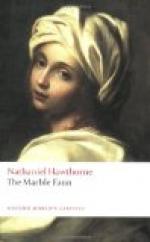As interesting as any of these relics was a large portfolio of old drawings, some of which, in the opinion of their possessor, bore evidence on their faces of the touch of master-hands. Very ragged and ill conditioned they mostly were, yellow with time, and tattered with rough usage; and, in their best estate, the designs had been scratched rudely with pen and ink, on coarse paper, or, if drawn with charcoal or a pencil, were now half rubbed out. You would not anywhere see rougher and homelier things than these. But this hasty rudeness made the sketches only the more valuable; because the artist seemed to have bestirred himself at the pinch of the moment, snatching up whatever material was nearest, so as to seize the first glimpse of an idea that might vanish in the twinkling of an eye. Thus, by the spell of a creased, soiled, and discolored scrap of paper, you were enabled to steal close to an old master, and watch him in the very effervescence of his genius.
According to the judgment of several connoisseurs, Raphael’s own hand had communicated its magnetism to one of these sketches; and, if genuine, it was evidently his first conception of a favorite Madonna, now hanging in the private apartment of the Grand Duke, at Florence. Another drawing was attributed to Leonardo da Vinci, and appeared to be a somewhat varied design for his picture of Modesty and Vanity, in the Sciarra Palace. There were at least half a dozen others, to which the owner assigned as high an origin. It was delightful to believe in their authenticity, at all events; for these things make the spectator more vividly sensible of a great painter’s power, than the final glow and perfected art of the most consummate picture that may have been elaborated from them. There is an effluence of divinity in the first sketch; and there, if anywhere, you find the pure light of inspiration, which the subsequent toil of the artist serves to bring out in stronger lustre, indeed, but likewise adulterates it with what belongs to an inferior mood. The aroma and fragrance of new thoughts were perceptible in these designs, after three centuries of wear and tear. The charm lay partly in their very imperfection; for this is suggestive, and sets the imagination at work; whereas, the finished picture, if a good one, leaves the spectator nothing to do, and, if bad, confuses, stupefies, disenchants, and disheartens him.
Hilda was greatly interested in this rich portfolio. She lingered so long over one particular sketch, that Miriam asked her what discovery she had made.
“Look at it carefully,” replied Hilda, putting the sketch into her hands. “If you take pains to disentangle the design from those pencil-marks that seem to have been scrawled over it, I think you will see something very curious.”
“It is a hopeless affair, I am afraid,” said Miriam. “I have neither your faith, dear Hilda, nor your perceptive faculty. Fie! what a blurred scrawl it is indeed!”




